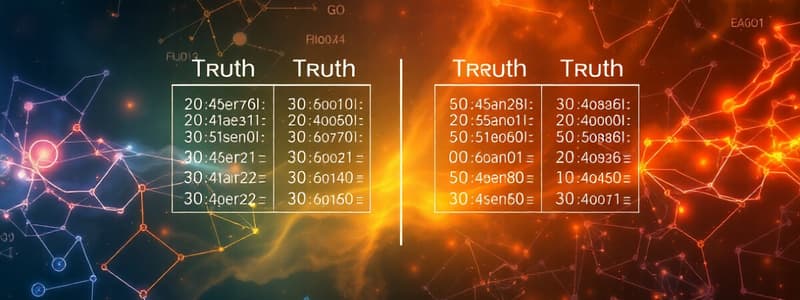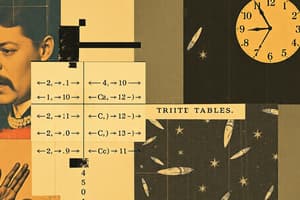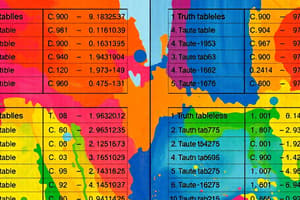Podcast
Questions and Answers
According to the Law of the Excluded Middle, what are the only two possible truth values for any statement?
According to the Law of the Excluded Middle, what are the only two possible truth values for any statement?
- Ambiguous or undefined
- Potentially true or potentially false
- True or false (correct)
- Partially true or partially false
What is the primary purpose of constructing truth tables?
What is the primary purpose of constructing truth tables?
- To memorize logical connectives
- To simplify complex arguments into shorter statements
- To express personal opinions regarding a topic
- To determine the validity or truth of a compound statement (correct)
Which of the following best describes a 'compound statement' in logic?
Which of the following best describes a 'compound statement' in logic?
- A statement composed of one or more simple statements. (correct)
- A statement that is always false.
- A statement that cannot be determined as true or false.
- A statement that contradicts itself.
What symbols are typically used to represent simple statements when constructing logical arguments?
What symbols are typically used to represent simple statements when constructing logical arguments?
When constructing a truth table, what is the first step you should take?
When constructing a truth table, what is the first step you should take?
If a compound statement consists of four simple statements, how many rows will its truth table have to account for all possible true-false combinations?
If a compound statement consists of four simple statements, how many rows will its truth table have to account for all possible true-false combinations?
In logic, what is the term for symbols that indicate the relationship between simple statements in a compound statement?
In logic, what is the term for symbols that indicate the relationship between simple statements in a compound statement?
When evaluating multiple connectives in a logical statement, in which order should you process them?
When evaluating multiple connectives in a logical statement, in which order should you process them?
If 'p' represents 'John scored a goal' and 'q' represents 'John won the game', how is the statement 'John did not score a goal' represented?
If 'p' represents 'John scored a goal' and 'q' represents 'John won the game', how is the statement 'John did not score a goal' represented?
Under what condition is a conjunction ('and') statement true?
Under what condition is a conjunction ('and') statement true?
A disjunction ('or') statement is false under which condition?
A disjunction ('or') statement is false under which condition?
When is a conditional statement ('if...then') considered false?
When is a conditional statement ('if...then') considered false?
Under what condition is a biconditional statement ('if and only if') true?
Under what condition is a biconditional statement ('if and only if') true?
Which of the following best describes a 'tautology'?
Which of the following best describes a 'tautology'?
What is the definition of a 'fallacy' in the context of logic?
What is the definition of a 'fallacy' in the context of logic?
Which term describes a logical expression that is always false, regardless of the truth values of its variables?
Which term describes a logical expression that is always false, regardless of the truth values of its variables?
What term describes a logical expression that can be either true or false, depending on the truth values of its variables?
What term describes a logical expression that can be either true or false, depending on the truth values of its variables?
What is a 'truth table'?
What is a 'truth table'?
What distinguishes a 'valid argument' in logic?
What distinguishes a 'valid argument' in logic?
What is the term for an argument that is not valid?
What is the term for an argument that is not valid?
Flashcards
Two-valued logic
Two-valued logic
Every statement is either True or False.
Truth tables
Truth tables
Used to determine the validity or truth of a compound statement.
Compound statement
Compound statement
Composed of one or more simple statements.
Simple statements
Simple statements
Signup and view all the flashcards
Premise
Premise
Signup and view all the flashcards
Identify the variables
Identify the variables
Signup and view all the flashcards
List all possible combinations
List all possible combinations
Signup and view all the flashcards
Evaluate the expression
Evaluate the expression
Signup and view all the flashcards
Connectives
Connectives
Signup and view all the flashcards
Negation
Negation
Signup and view all the flashcards
Conjunction
Conjunction
Signup and view all the flashcards
Disjunction
Disjunction
Signup and view all the flashcards
Conditional
Conditional
Signup and view all the flashcards
Biconditional
Biconditional
Signup and view all the flashcards
Tautology
Tautology
Signup and view all the flashcards
Fallacy
Fallacy
Signup and view all the flashcards
Contradiction
Contradiction
Signup and view all the flashcards
Proposition
Proposition
Signup and view all the flashcards
Logical operator
Logical operator
Signup and view all the flashcards
Valid argument
Valid argument
Signup and view all the flashcards
Study Notes
- Mathematicians use two-valued logic, where every statement is either True or False.
- This concept is called the Law of the Excluded Middle.
- Statements in sentential logic are built from simple statements using logical connectives.
- Truth or falsity depends on the truth or falsity of its components.
Truth Tables
- Used to determine the validity or truth of a compound statement.
- A compound statement consists of one or more simple statements.
- Simple statements are represented by symbols (often letters).
- Each symbol signifies a statement, like “John scored a goal” or “It is raining”.
- Constructing a truth table depends upon the simple statements composing the compound statement.
- A statement can be referred to as a premise or expression, depending on the context.
Steps to Construct a Truth Table:
- Identify the variables present in the logical expression.
- List all possible combinations of true and false values for each variable.
- Evaluate the expression for each combination of truth values and record the result.
Truth Table Example, Two Simple Statements:
- If p=John scored a goal and q=It is raining
- When both John scored a goal and It is raining are both true, both events occurred.
Truth Table Example, Three Simple Statements:
-
The number of times T appears consecutively in each column is determined by the number of statements.
-
The formula for the number of times T is listed consecutively under statement p is 2 squared.
-
The formula for the number of times T is listed consecutively under statement q is 2 to the power of 1.
-
The formula for the number of times T is listed consecutively under statement r is 2 to the power of 0.
-
The number of times T is listed consecutively in the first statement is half the number of true-false cases.
-
The number of true-false cases doubles with the addition of one statement.
-
The total number of cases is determined by 2 to the power of the number of statements.
Connectives
- The truth of a compound statement depends on the simple statements and the connective used.
- Connectives are symbols indicating the relationship between simple statements.
Common Connectives:
- Includes negation, conjunction, disjunction, conditional, and biconditional
- When multiple connectives are used, their truth must be determined in a specific order.
Connective Examples:
- p represents the statement "John scored a goal" and q represents "John won the game."
Negation ("Not"):
- Complete negation first.
- The statement is true when the input statement is false.
- ~p represents "John did not score a goal."
Conjunction ("and"):
- Complete conjunction second along with disjunction.
- The statement is true only when both input statements are true; otherwise, it's false.
- p ∧ q represents "John scored a goal and won the game."
Disjunction ("or"):
- Complete disjunction second along with conjunction.
- The statement is false only when both input statements are false; otherwise, it's true.
- p V q represents "John scored a goal or won the game."
Conditional ("if...then"):
- Complete conditional third.
- The statement is false only when the first input statement is true, and the second is false otherwise, it's true.
- p → q represents "If John scored a goal, then won the game."
Biconditional ("if and only if"):
- Complete biconditional last.
- The statement is true when both input statements are true or both are false; otherwise, it's false.
- p ↔ q represents "John scored a goal if and only if he won the game."
Definitions of Terms Related to Truth Tables and Logic:
- Tautology: A logical expression that is always true, regardless of the truth values of its variables.
- Fallacy: An error in reasoning or a faulty argument due to a flaw in the reasoning or premises.
- Contradiction: A logical expression that is always false, regardless of the truth values of its variables.
- Contingency: A logical expression that can be either true or false, depending on the truth values of its variables.
Other Related Terms:
- Proposition: A statement that can be either true or false.
- Truth value: The truth or falsity of a proposition.
- Logical operator: A symbol used to connect propositions to form more complex propositions.
- Truth table: A table that shows the truth values of a logical expression for all possible combinations of truth values of its variables.
- Valid argument: An argument in which the conclusion logically follows from the premises.
- Sound argument: A valid argument with true premises.
- Invalid argument: An argument that is not valid.
- Unsound argument: An argument that is either invalid or has false premises.
Studying That Suits You
Use AI to generate personalized quizzes and flashcards to suit your learning preferences.




